Weather Almanac for May 2005
THE GREAT 1840 NATCHEZ TORNADO

In 1840, the Mississippi River settlement of Natchez, Mississippi was a well-established city. The city proper, perched on the river's highest promontory (61m [200 feet]) north of the Gulf of Mexico, boomed as a port during the first half of the 19th century. In fact, Natchez, settled by the French in 1716, was two years older than New Orleans and the oldest European settlement on the river. Inhabited for centuries by native Americans prior to the French, the settlement came under British rule in 1763, then under the Spanish in 1779. Finally in 1798, the Americans took control and Natchez became the first capital of the Mississippi Territory. When Mississippi joined the union in 1817, its first capital was located there. With the arrival of steamboats on the Big Muddy, the city boomed as cotton grown in the rich lowlands of Mississippi and Louisiana was shipped down river to New Orleans.
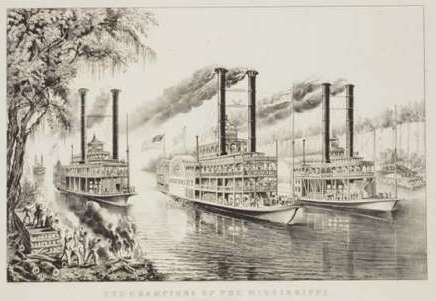
The Champions of the Mississippi: "A race for the Buckhorns" Currier & Ives, 1866
On May 7th of that fateful year, this river city would suffer the greatest tornado strike in the nation's entire history until the great Tri-State Tornado of 1925. By all reasonable contemporary accounts, the death toll reached 317, which still ranks second in US killer-tornado annals. The figure may have been higher because storm-related deaths of black slaves were likely not included. The total damage in 1840 dollars was conservatively estimated at $1,260,000, though the Natchez Mississippi Daily Free Trader placed the first estimate at $5 million.
Setting the Scene
The weather in the southern Mississippi River Valley had been active during the first days of May 1840. According to the records of Natchez's long-time weather observer Henry Tooley, a stretch of overcast and humid weather had broken on May 4th when a cold front swept through the area. (Tooley had served as the local weather observer since 1825, continuing a long tradition in the city.)
The clearing of the air lasted but a few days, and muggy weather had returned by the 6th. Tooley's records indicate southerly winds and temperature in the middle 80's (degrees Fahrenheit) during his early evening observation, an indication that tropical air from the Gulf of Mexico was again present over Natchez. A falling barometer and drizzle characterized that afternoon, and the day remained overcast. To the northwest, in the southwestern Arkansas community of Washington, Dr Nathan D. Smith recorded in his weather journal on the night of the 6th that thunderstorms rumbled and dropped almost three inches (75 mm) of rain.
The Fateful Day
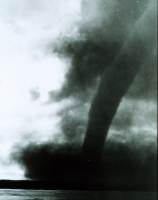 May 7th dawned at Natchez thick with clouds and very warm. From weather accounts in areas surrounding Natchez, a strong frontal system was passing over the lower Mississippi valley. At New Orleans, the barometric pressure would bottom out in the early evening. Winds at New Orleans in the afternoon were from the southeast at 45 mph (72 km/h). Dr Martin Phillips at Edwards, Mississippi (70 miles [112 km] east of Natchez) and Bennet A. Barrow of Florida Parish, Louisiana both noted vigorous winds and heavy rains with the passage of a cold front on the 7th and clear, unseasonably cold conditions with northerly winds by May 9. May 7th dawned at Natchez thick with clouds and very warm. From weather accounts in areas surrounding Natchez, a strong frontal system was passing over the lower Mississippi valley. At New Orleans, the barometric pressure would bottom out in the early evening. Winds at New Orleans in the afternoon were from the southeast at 45 mph (72 km/h). Dr Martin Phillips at Edwards, Mississippi (70 miles [112 km] east of Natchez) and Bennet A. Barrow of Florida Parish, Louisiana both noted vigorous winds and heavy rains with the passage of a cold front on the 7th and clear, unseasonably cold conditions with northerly winds by May 9.
Tooley's report on the conditions and events of the 7th describes the winds as southerly and brisk in the morning. They increased and veered easterly by noon. At the meridian hour, he observed the southwestern sky "assumed a darker and more tempestuous aspect, the gloom and turbulence increasing every moment."
Unbeknownst to Tooley, a massive tornado had touched down around 20 miles (33 km) to the southwest in Louisiana and had begun moving northeastward. It reached the Mississippi River 7 miles (11 km) down river from Natchez and moved upriver, stripping the forest along both shores.
At approximately 12:45 pm, "the roar of the approaching storm began to be distinctly heard, the wind blowing a gale, NE 6 [Beaufort wind force number]," wrote Tooley. "The roar and commotion of the approaching storm grew more loud and terrific, attended with incessant corruscations [sic] and flashes of forked lightning. As the storm approached nearer, the wind veered to the E.7. At 1:45 the storm cloud assumed an almost pitchy darkness, curling, rushing, roaring above, below a lurid yellow dashing upward and rapidly approaching..."
Across the river in Louisiana on the plantation of Walton Smith Esq., the tornado devastated all along its half-mile wide path as it moved up the western riverbank. South of Vidalia, Louisiana, the funnel jumped the Mississippi at the Natchez island below the plantation of David Barland, Esq. and opposite the plantations of P.M. Lapice, Esq. in the Concordia (LA) parish. It moved past the mansion called the Briers, a mile and a half below the city (now a Natchez heritage building). The Briers was only slightly damaged, but the twister swept away the mansion called the Bellevue and the "ancient forest in which it was embosomed into a mass of ruins."
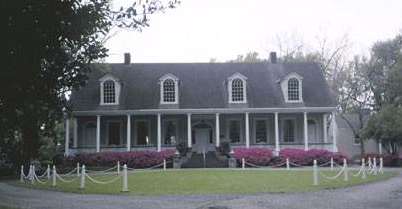
The Briers today, photo courtesy City of Natchez
The tornado then struck the riverport of Natchez Landing, located below the bluff from Natchez. The mile-wide funnel tossed sixty flatboats into the seething Mississippi, drowning their crews and passengers. A piece of a steamboat window was reportedly found 30 miles (50 km) from the river. Many doing business onshore were also killed. At Natchez Landing, the destruction of dwellings, stores, steamboats and flatboats was almost complete from the Vadalia ferry to the Mississippi Cotton Press, only a few torn dwelling fragments remained.
"No calculation can be made of the amount of money and produce swallowed up by the river. The Steamboat Hinds, with most of her crew, went to the bottom, and the Prairie from St. Louis, was so much wrecked as to be unfit for use. The steamer St. Lawrence at the upper cotton press is a total wreck." reported the Free Trader in the issue dated Friday, May 15, 1840.
HORRIBLE STORM!! NATCHEZ IN RUINS!!!
So the Free Trader headlined the story: " Our devoted city is in ruins, and we have not a heart of stone to detail while the dead remain unburied and the wounded groan for help."
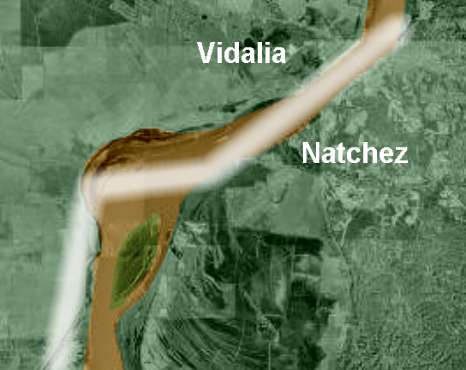 Approximate path of Natchez Tornado
based on contemporary accounts.
On the day following the storm (Friday, May 8, 1840), the Free Trader headline read: Dreadful Visitation of Providence. "The dinner bells in the large hotels had rung and most...citizens were sitting at their tables," it reported, "when, suddenly, the atmosphere was darkened, so as to require the lighting of candles; and, in a few moments afterwards, the rain was precipitated in tremendous cataracts rather than in drops. In another moment the tornado, in all its wrath, was upon us. The strongest buildings shook as if tossed with an earthquake. The air was black with whirling eddies of house walls, roofs chimneys, huge timbers torn from distant ruins, all shot through the air as if thrown from a mighty catapult."
It then struck Natchez but its full width of devastation also included the river and the Louisiana village of Vadalia across the river, making the tornado over two miles in width. The rush of the tornado, Tooley estimated, likely did not exceed five minutes, the first wave of its destructive blast not more than a few seconds but it hit like the explosive force of gunpowder. Hundreds of rooms burst as if barrels of gunpowder had been ignited in each. Ever the scientific observer, as the city crashed around him, he noted the barometer at this time fell to 29.37 inches (994.6 mb).
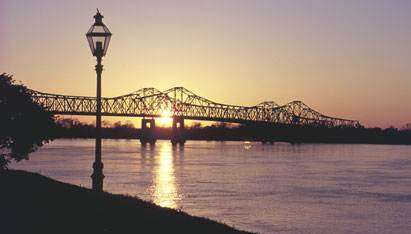
The Natchez Riverfront today, at the approximate
location the tornado struck Natchez Landing.
photo courtesy City of Natchez
In the city proper, scarcely a house escaped damage or destruction. The steeples of the Presbyterian and Methodist churches were thrown down, their walls were shattered and roofs broken. The Episcopal church lost its roof. Parker's great Southern Exchange was levelled as was the railroad depot. The Natchez theater formed "a pile of shapeless ruins, beyond recovery." The Planter's Hotel and the Steam-boat Hotel were now ruins, while the City Hotel and the Mansion House sustained great damage; both unroofed and the upper stories stove in. Hundreds of private dwellings are in similar situations.
In reporting the first accounts of the story, the Free Trader begged the indulgence of their "kind friends and patrons for a few days in which time we shall be able to get our office in some order. The Free Trader office building has been crushed in and much shattered." (May 8, 1840)
Across the river in Louisiana, the Court House in Vidalia, was utterly destroyed, while the Concordia parish jail sustained heavy damage.
"We are all in confusion, and surrounded by the destitute, the houseless, the wounded and the dying. Our beautiful city is shattered as if it had been stormed by all the cannon of Austerlitz. Our delightful China trees all torn up," reported the Free Trader (Friday, May 8, 1840). "The neighboring planters are generously sending in large gang's of slaves to assist in clearing the streets and digging the dead from the ruins."
The first estimates of death and injury were high:
"The estimate of the number of lives lost, by intelligent men from Natchez, is from 500 to 1000: but it was impossible to assertain [sic] the number with any thing like certainty, untill [sic] the rubbish was cleared away, which will require several weeks....It has been assertained [sic] that there were 104 flat boats at the landing, only seven of which were saved....At the principal hotel, the boarders to the number of 60 or 80, were at dinner, and only 7 or 8 have been seen since....At the Steam Boat Hotel under the hill, about 60 were at dinner-only six have been found alive."
"The estimate of a little more than a million and a quarter of dollars for the damage done to the buildings merely may be nearly correct for the compact part of the city; but to cover the loss of merchandise, provisions, goods of various kinds and furniture destroyed there should, in the opinion of some of our practical and clear headed men, be at least, four millions more added-making the entire loss of property in the city of Natchez more than FIVE MILLIONS OF DOLLARS."
This estimate, we believe to be strictly within the bounds of moderation. The immence [sic] quantity of pork, bacon, butter, lard and vegetables lost at the landing, swept into the deep and oblivious river, would astonish any one not acquainted with the nature of our trade. Many of our large Ware Houses and furnishing stores, having lately been crippled and restricted in their operations, the most of the supplies for city, county and the adjacent counties have been derived from the Natchez Landing; these now, with a very few exceptions, are whelmed in the ruins, or lost in the waters. Free Trader (Sunday, May 10, 1840)
Aftermath
The final and most reliable death toll after the horror subsided reported 48 fatalities on land and 269 on the river — most from flatboats and steamers — a total of 317 with 109 injured. The Free Trader (May 12, 1840) marvelled at that count, "The only wonder is that so few were killed in the fierce conflict of the elements, the furious whirlpool of timbers, falling roof and crashing walls."
Quite possibly, there were many more deaths, for, in this pre-Civil War era, slaves were not always counted. At least one person died in Vidalia, Louisiana. Reports that hundreds were killed on plantations in Louisiana were never confirmed, but it is quite possible that there were many more deaths in areas outside Natchez. Press reports indicate that tornadoes or tornado-like storms struck portions of Arkansas the same day.
Henry Tooley would compile his observations a few weeks later of the explosive effects he saw on local buildings as the tornado passed.
"In the course of the tornado over the city in hundreds of instances proof irresistible was shown, that in the rush of the storm over the house, the external atmospheric pressure was so taken off that the atmosphere within the house suddenly expanded so as to force an outlet either by blowing off the roof, bursting open doors and windows, driving outward gable ends, or the whole or parts of walls; on the contrary were leeward doors or windows or trapdoors of the roofs were open, no such destructive effects were produced." (Letter to M.H. Webster printed in J.P. Espy, Philosophy of Storms, 1941.)
These conclusions would be supported by 14 specific building observations. He also reported the storm winds stripped the vitality out of leaves and buds, but "such as did not die outright, were crisped, and their growth so suspended, that it was for ten or more days before they resuscitated and began again to grow."
Eight-five years would pass before the death toll from a tornado would surpass the "official" count of the 1840 Natchez tornado. The Great Tri-State Tornado on March 18, 1925 would claim 695 lives, though some believe that the fact the death and destruction were spread over three and a half hours indicates this was not one super tornado but a close-packed swarm.
Tornado photo, courtesy Historic NWS Collection, NOAA
Learn More About Tornadoes From These Relevant Books
Chosen by The Weather Doctor
- Grazulis, Tom P.: The Tornado: Nature's Ultimate
Windstorm, 2001, University of Oklahoma Press, Norman, paperback, ISBN: 0806135387: Hardcover Edition.
- Bluestein, Howard B.: Tornado Alley: Monster Storms of The Great Plains, 1999, Oxford University Press, New York, ISBN 019-510552-4.
Written by
Keith C. Heidorn, PhD, THE WEATHER DOCTOR,
May 1, 2005
The Weather Doctor's Weather Almanac The Great 1840 Natchez Tornado
©2005, Keith C. Heidorn, PhD. All Rights Reserved.
Correspondence may be sent via email to: see@islandnet.com.
For More Weather Doctor articles, go to our Site Map.

I have recently added many of my lifetime collection of photographs and art works to an on-line shop where you can purchase notecards, posters, and greeting cards, etc. of my best images.

Home |
Welcome |
What's New |
Site Map |
Glossary |
Weather Doctor Amazon Store |
Book Store |
Accolades |
Email Us
|



|











